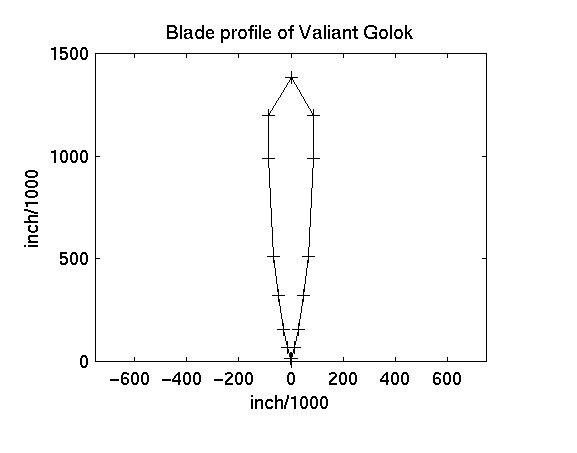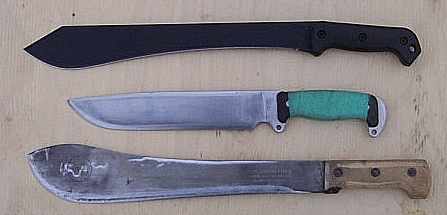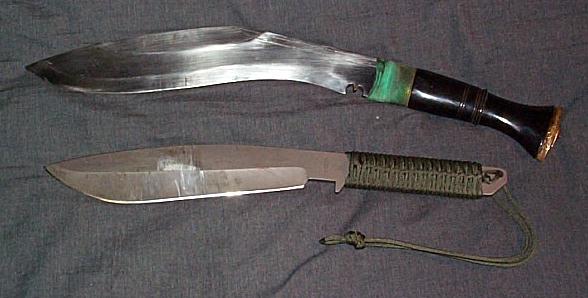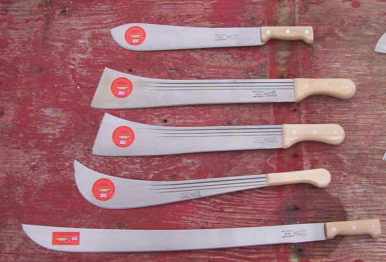A shot of the Valiant Survival Golok L from the Valiant Co. website :
The review consists of :
The Survival Golok is made by Valiant Trading Company, it is one of the blades of Java. This sample weighs 590 g with a 40 centimeter blade which balances 9.5 centimeters in front of the handle, 10.5 centimeters in front of the center of the index finger using a grip on the far front of the handle. This weight and balances gives the Golok a similar heft as the Busse Battle Mistress, but it feels lighter in hand because as the grip is wider and reduces contact pressure. The primary blade grind is a dual tapered convex with a false edge. The convex curvature tapers to a very acute edge, about 10 degrees per side until the blade hits about 0.056" in thickness, at which point the grind sweeps back even faster. Here is a shot of the entire profile :

the numbers in detail :
| Thickness | Width | Angle |
|---|---|---|
| 0.000 | 0.000 | |
| 0.006 | 0.017 | 10 |
| 0.028 | 0.070 | |
| 0.056 | 0.155 | |
| 0.097 | 0.320 | 7 |
| 0.133 | 0.510 | |
| 0.175 | 0.987 | |
| 0.170 | 1.200 | |
| 0.000 | 1.382 |
These cross section measurements were taken at the halfway point in the blade. The knife has a significant taper so the profile will be slimmer towards the tip and slightly thicker towards the handle. This is by far the most acute geometry I have seen in a production wood working blade of this size. It is the equal of the a quality forged bowies, from Ray Kirk for example who has won multiple ABS cutting contests. Since cutting ability is strongly dependent on geometry, this indicates that the golok's performance is going to be near the top, many to one over the common "tactical" profiles on current large fixed blades.
The primary grind shows some heavy scratches and a forge mark. There are also "waves" in the bevel which can be felt by hand. The false edge is also slightly skewed to one side and has a visble file mark along about five inches of its length. The tang is not fully seated into the handle, about one millimeter of gap is present, and on one side the tang is formed with a very square transition, a bad place for a stress riser.
The initial sharpness ranged from decent to poor. The first four inches were very dull, little fine cutting ability. A section two inches long in the middle of the Golok and six inches of the tip could for example slice paper, but would tear it in sections. The top edge would not catch on a fingernail. The first few inches of the blade also don't have the edge formed, a common safety precaution on large brush blades.
Valiant Survival Golok L was used for an extended period of time alongside a Tramontina Bolo and Busse Combat Battle Mistress (green tape on handle) shown here alongside a Patrol Machete (black blade) :

18" Ang Khola shown alongside a PAB from Strider (cord wrapped handle) :

and two machetes from Martindale, a #23W and a #32L which are the bottom two blades respectively in the following picture :

A short overview of the specifics of the above blades, full details can be seen in the individual reviews :
| Knife | Mass | Balance point | Blade length |
|---|---|---|---|
| grams | cm | ||
| Valiant Survival Golok L | 590 | 9.5 | 40.0 |
| Battle Mistress | 660 | 2.5 | 26.0 |
| 18" Ang Khola | 920 | 9.5 | 31.0 |
| #32L | 445 | 12.0 | 45.0 |
| #23W | 630 | 23.0 | 68.5 |
The balance point is measured from the start of the handle, the blade length is the total length from the start of the handle to the tip, it gives the reach of the blades. The actual cutting edge length is shorter on each blade due to unsharpened choils.
Though the blades were radically different in size and shape, cutting ability on grasses simply favored which ever blade was freshly sharpened, pretty much ignoring geometry. It takes a very sharp blade to cut grass well, as sharpness is reduced then the blades have to be used in a slicing motion as they will fail on push cuts and just push the grass around, this is common in general for cutting many media, having to resort to sawing.
With all blades very sharp, the #32L was clearly the best similar due to its reach, it is the optimal blade for such work outside of a scythe. The #23W and Valiant Golok were significantly behind and they didn't have the length to cut close to the ground, and they have to be used with a "duck walk" to trim the grass close to the ground. The machete had the edge over the Golok in terms of fatigue as it was lighter. The Battle Mistress and khukuri are significantly behind, the Battle Mistress lacks reach and the 18" Ang Khola is just overkill, far too much heft in hand for really light work.
The performance here was very similar to on the grasses, again sharpness was very critical. Some work was done with the Golok on hard woods and the slight loss of sharpness made an obvious difference on ease of cutting. The main difference from the grass cutting was that as the vegetation was thicker there was benefit to having more power behind the blade. This was not enough to make the weight and very forward balance of the 18" Ang Khola necessary however it did pull the Golok and #23W machete together.
Alders are very soft wood, white pine is harder for example. On small alders, under a half inch thick, the same tendancy was seen for the more powerful blades to start to show their benefit, but it still wasn't enough to favor the 18" Ang Khola and even the #23W still cut the small alders very well and again the #32L was clearly the best choice due to reach. However on thicker alders, they get up to 2-3" locally, the machetes have problems due to lack of stiffness and the Golok is the most effective, in the short term this is followed by the 18" Ang Khola and Battle Mistress. For extended work the Battle Mistress tends to pull ahead of the 18" Ang Khola because the khukuri is still a bit too much blade for this type of wood and the fatigue rate is thus high.
The Golok took 7.3 (5) slices to point a one inch basswood dowel which is very solid performance for a knife of its size. It is far more efficient for this type of work than the #32L machete and 18" Ang Khola which are very awkward. The #23W machete handles well but the edge is fairly obtuse near the handle and the carving ability is less than half that of the Golok. The Battle Mistress carves wood just as well as the Golok and is much easier to manipulate due to the shorter blade length.
As the wood got harder the machetes fell further behind, vibration became a significant problem with the #32L . The Golok has the best balance of reach and cutting ability however the edge did dented on the harder limbs. The 18" Ang Khola is more fluid in the woods and its greater power tended to be of benefit on the larger limbs. The Battle Mistress had the same level of cutting ability as the Golok but its lower reach reduced its efficiency.
All of the blades had solid penetration on pine which is a soft wood, the main difference was fluidity as the stamped flat stock blades tended to wedge badly. The Bolo for example on occasion bound so heavily that the wood had to be braced to work the blade out. The machetes had similar issues with binding and also excessive vibrations due to lackof stiffness. The Golok had the same raw penetration as the Bolo, 92 +/- 5% though 13 sections of wood, however the Golok was much more fluid and was competitive with the 18" Ang Khola for the top spot excet the Golok took a bend attemping to pry out a chip with wrist action, it would take a bend with a simple slap off the side of a log. The 18" Ang Khola had significantly better penetration than the Battle Mistress and was more fluid in the wood.
The upswept curvature of the Golok induces a slicing action readily on light vegetation which is enhanced by drawing the blade through the material rather than attempting a straight push cut. When used with a heavy draw on light vegetation the performance is generally improved both with respect to cutting ability and edge retention if the finish is left more coarse. The natural upsweep of the Golok also enhances thick wood cutting as this presents the optimal profile to the wood, similar to the bit of a felling axe which has a very light curvature. This mainly gives a much smoother cut which reduces fatigue in extended use. However with a coarse edge the chopping performance on thick woods will degrade readily so an optimal sharpening leaves the sweet spot in the middle of the blade with a high polish for wood chopping and the tip more coarse for slicing light vegetation.
The edge retention of the Golok with the initial profile is fairly low through the tip as it isn't hardened, it would rolled visibly even on the light vegetation when the stalks were dry and hardened. This was not an issue with a poor initial edge as can often be an issue as it continued even after the blade was sharpened, it just has to do with the low hardness through the tip which eliminates several inches of functional blade length.
The Golok also took visible dents on the light limbing, up to 0.030" thick sections of blade were visibly deformed to the side. Pine is a fairly soft wood and the limbing was done carefully to minimize stress, clipping off the limbs individually with no sweeping. The poor durabilty shown was likely due to forging imperfections which left sections of the edge with signifiant hollow grinds.
To bring the blade closer to optimal performance in regards to durability a belt sander was used to remove all the hollows in the primary grind producing a smooth convex profile. The hollows were concentrated in the region that dented during the limbing. The blade ground easily, it took around twenty minutes to completely smooth out the profile and conserve the efficient curvature. The profile was thinned a little by the grinding but the width was not altered. The Golok was readily sharpened using waterstones and finished with 0.5 micron chromium oxide loaded leather and would now shave smoothly along the entire edge.
With the reground edge the Golok had no problems limbing with the section of blade which is fully hardened which starts about three inches infront of the choil and extends for another six inches. However when the tip still took damage readily as it is too soft. When used to sweep off dead limbs it took heavy ripples in the first few swings and within a dozen cuts there were multiple ripples large enough so that they could be seen at arms length. After about five hundred swings the dents had grown until they were past 1/16" to the side. The edge then quickly broke away as the ductility was exceeded and the steel tore.
Due to the limbing, steel was lost from the tip for about one and a half inches in length. The damage extended to to about 1/8" deep, the blade was 0.060" thick at the back of the damage. The handle also cracked, the depth of the crack was about an inch and a half. To check the extent at the handle damage, short wrist pops, just a few inches of drop, where used to chop the Golok into a log. The handle gave with each chop and the blade fell out after two dozen impacts. The tang is nice and thick however is sharp on the back which is probably what induced the cracking in the first place.
The blade was locked in a stump and bent to check the strength and flexibility. It bent easily due to the soft spine and took a set right at the point it was locked in the stump with little curvature in the rest of the blade. the ductility was very high as it easily went to 180 degrees bending around the stump. The edge cracked up to 1/2" deep in the region where it was locked in the stump.
The grip on the Golok is one of its strong features. It is secure and comfortable, though some might find the carvings abrasive. It however cracked during the pine bucking, right through to the back of the handle, which propagated it down about one inch. The tang appears to be left squarish, which isn't good for shock absorption at the tang/grip juncture.
The scabbard is a simple slip sheath, it doesn't hold the blade very securely and has much lower durability vs impacts than even kydex. It was flexed lightly across the leg and cracked readily and further fractured when it was walked on. A short swing at a 4x4 cracked the top of the scabbard further.
The primary profile of the Golok is optimal for a wood working blade. However there are issues with performance due to the tip, choil and spine all left very soft which reduces the strength significantly. A the Cold Steel shovel could readily cut into the false edge, tip and choil of the Golok with no damage to the edge of the shovel.
The Golok also needed a full sharpening to remove the hollows in the edge left by forging. The grip is secure and ergonomic though it came loose with extended wood chopping. The sharpened top edge was of little use as it is too obtuse to cut effecitvely and not hardened so it would dent up readily if used for really heavy cutting. It also reduces efficiency when batoning and interfers with using the Golok as a draw knife.
In regards to modifications, forming the edge all the way down to the handle would give better fine utility performance. The tip and choil would benefit from greater hardness for better edge retention and the spine should be spring tempered and not annealed to make the blade more rigid to enable heavier wood working. The scabbard is basically a slip case, it would be nice to have a way to actually wear it such as the rig that Camillus has for the Patrol Machete which is just nylon over a plastic slip case.
Comments can be sent to : cliffstamp[REMOVE]@cutleryscience.com or posted to :
Jim Aston has several reviews of Valiant products on Jimbo's Survival Page, Valiant's website also contains additinal information. Another sample of the Golok was also used :
| Last updated : | Fri Apr 4 12:09:07 NST 2003 |
| Origionally written : | Mon Feb 24 12:01:31 NST 2003 |